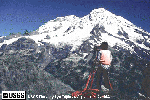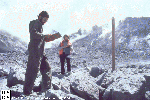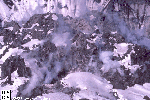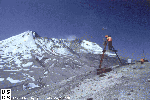
USGS/Cascades Volcano Observatory, Vancouver, Washington
CVO Photo Archives -
Deformation Monitoring Images
-
 [Image,54K,JPG]
[Image,54K,JPG]
Deformation monitoring at Mount Rainier, using helicopter and EDM.
-- USGS Photo by Lyn Topinka, September 12, 1983
-
 [Image,86K,JPG]
[Image,86K,JPG]
USGS Spirit-Level tilt measurements at Mount Rainier.
Using a triangular system of benchmarks, changes in the ground
surface are recorded.
-- USGS Photo by Lyn Topinka, 1983
-
 [Image,29K,JPG]
[Image,29K,JPG]
Establishing baselines, deformation monitoring, Newberry Caldera.
-- USGS Photo by Lyn Topinka, August 20, 1985
-
 [Image,305K,GIF]
[Image,305K,GIF]
Global Positioning System (GPS) receiver at Cotopaxi Volcano, Ecuador. GPS uses data transmitted by orbiting
satellites to locate points on the ground. The USGS has made baseline GPS measurements at several volcanoes in the
United States and in Latin America. In the event of an awakening of one of these volcanoes, GPS receivers would be
set up at these points again to determine whether or not measurable deformation had occurred and to monitor for
precursory deformation that might herald an eruption.
-- USGS Photo by J. W. Ewert
-
 [Image,43K,JPG]
[Image,43K,JPG]
A "bulge" developed on the north side of Mount St. Helens as magma pushed up
within the peak. Angle and slope-distance measurements to the
bulge indicated it
was growing at a rate of up to five feet (1.5 meters) per day.
By May 17, part of the
volcano's north side had been pushed upwards and outwards over
450 feet (135 meters).
The view is from the northeast.
-- USGS Photo by Peter W. Lipman, April 27, 1980
-
 [Image,69K,JPG]
[Image,69K,JPG]
The U. S. Geological Survey has established both periodic and continuous 24-hour
monitoring programs of Mount St. Helens to study and predict eruptions. In this
slide, geologists use a steel tape to measure the distance across a crack on the
crater floor. Widening of cracks is an indication that magma is rising and
deforming the area, leading to an eruption. These cracks are generally
radial to the dome, like spokes of a wheel.
-- USGS Photo by Lyn Topinka, May 12, 1981
-
 [Image,82K,JPG]
[Image,82K,JPG]
Geologists use a theodolite and EDM (Electronic Distance Meter) to measure angles
and slope-distances to the lava dome. Changes in these angles and distances are
used to calculate "deformation rates". An increase in deformation rates is an
indication that magma is slowly entering the dome.
Deformation rates often reach
30 feet per hour (10 m/hr) as magma rises and the dome expands before extrusion
starts. During the winter months, the instrument stations often
have to be dug out
of the snow before measurements can be made.
-- USGS Photo by Lyn Topinka, May 26, 1984
-
 [Image,66K,JPG]
[Image,66K,JPG]
Geologists measure the strength of the magnetic field surrounding the dome. The
strength of the field increases as the dome cools and magnetic minerals form.
During the eruptions the strength usually changes rapidly
as magma heats and deforms the dome.
-- USGS Photo by Lyn Topinka, June 18, 1984
-
 [Image,101K,JPG]
[Image,101K,JPG]
Geologists do precise leveling to measure changes in the slope of the
crater floor, due to moving magma. Changes in slope are also measured
electronically by tiltmeters. Tiltmeters allow 24-hour monitoring as the information
is telemetered back to CVO. Other instruments such as displacement meters for measuring
cracks, seismometers for measuring earthquakes,
gas sensors for measuring gas concentrations, and
magnetometers for measuring the magnetic field,
are also used for 24-hour monitoring.
-- USGS Photo by Holly Martinson, May 1982
-
 [Image,79K,JPG]
[Image,79K,JPG]
In 1983, the U. S. Geological Survey extended both its periodic and
its 24-hour monitoring programs to the top of Mount St. Helens' dome.
In this aerial view, three geologists (middle bottom) are busy taking
measurements to determine deformation rates.
-- USGS Photo by Lyn Topinka, April 18, 1988
-
 [Image,57K,JPG]
[Image,57K,JPG]
The U. S. Geological Survey also maintains a network of monitoring
stations around the base of Mount St. Helens. Angle and distance
measurements to the volcano's flanks are taken periodically to watch
for any deformation similar to the 1980 bulge. Pictured here is an
instrument station northeast of the volcano.
-- USGS Photo by Lyn Topinka, May 15, 1989
-
 [Image,44K,JPG]
[Image,44K,JPG]
Geologists use a theodolite and EDM to
measure angles and slope-distances from Harrys Ridge (5 miles to
the north) to Mount St. Helens crater and lava dome, 1981
-- ISGS Photo by Lyn Topinka, October 31, 1981
-
 [Image,44K,JPG]
[Image,44K,JPG]
Geologists measure angles and slope-distances from Harrys Ridge (5 miles to
the north) to Mount St. Helens crater and lava dome, 1984
-- ISGS Photo by Lyn Topinka, March 22, 1984
Return to:
[CVO Photo Archives Menu] ...
[Volcano Deformation Project Menu] ...
[Volcano and Hydrologic Monitoring Menu] ...

Use of CVO Material and Copyright Information
URL for CVO HomePage is:
<http://vulcan.wr.usgs.gov/home.html>
URL for this page is:
<http://vulcan.wr.usgs.gov/Photo/Monitoring/Deformation/images.html>
If you have questions or comments please contact:
<GS-CVO-WEB@usgs.gov>
03/25/02, Lyn Topinka
 Use of CVO Material and Copyright Information
Use of CVO Material and Copyright Information

 Use of CVO Material and Copyright Information
Use of CVO Material and Copyright Information
 [Image,54K,JPG]
[Image,54K,JPG]
 [Image,86K,JPG]
[Image,86K,JPG]
 [Image,29K,JPG]
[Image,29K,JPG]
 [Image,305K,GIF]
[Image,305K,GIF]
 [Image,43K,JPG]
[Image,43K,JPG]
 [Image,69K,JPG]
[Image,69K,JPG]
 [Image,82K,JPG]
[Image,82K,JPG]
 [Image,66K,JPG]
[Image,66K,JPG]
 [Image,101K,JPG]
[Image,101K,JPG]
 [Image,79K,JPG]
[Image,79K,JPG]
 [Image,57K,JPG]
[Image,57K,JPG]
 [Image,44K,JPG]
[Image,44K,JPG]
 [Image,44K,JPG]
[Image,44K,JPG]
